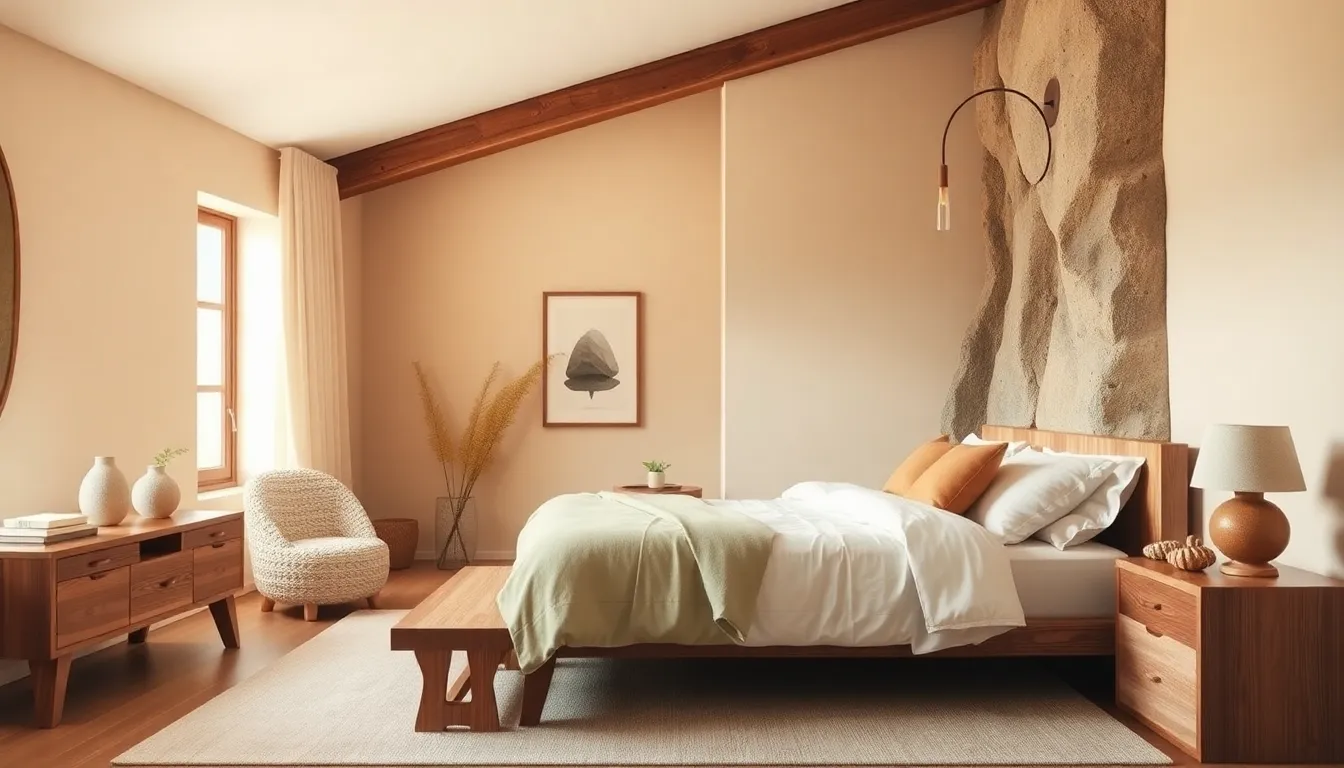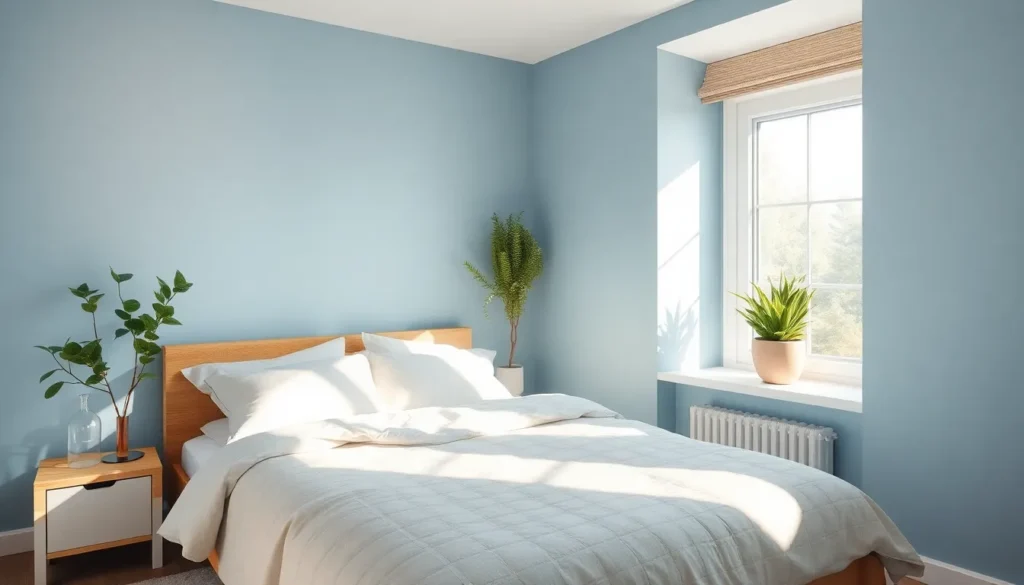Table of Contents
ToggleChoosing the right paint color for a bedroom can feel like a high-stakes game of roulette. One wrong move and you could end up sleeping in a neon green cave or a drab beige box. Fear not, because the perfect palette is out there waiting to transform your space into a serene sanctuary or a cozy retreat.
Imagine curling up in a room that feels like a warm hug or a refreshing breeze. The right color can set the mood, boost your creativity, or help you unwind after a long day. From calming blues to energizing yellows, the best paint colors for bedrooms can elevate your sleeping space from blah to beautiful. Buckle up as we dive into the world of hues that’ll make your bedroom the envy of all your friends—because who wouldn’t want to wake up in a masterpiece?
Best Paint Colors for Bedrooms
Choosing the right paint color for a bedroom significantly impacts its ambiance. Soft blues promote relaxation and tranquility, making them ideal for enhancing sleep quality. Light grays offer a neutral palette that complements various decor styles while maintaining a calm environment.
Warm whites provide brightness without overwhelming the senses. They reflect natural light, creating a more spacious feel in smaller rooms. Earthy tones, like soft greens and muted browns, bring a nature-inspired element that fosters a cozy atmosphere.
Rich jewel tones like deep blues or emerald greens add depth and warmth, transforming a simple space into a luxurious retreat. Light pastels, such as lavender and peach, create an inviting and cheerful mood without being overpowering.
For those who prefer bold choices, consider energetic yellows or vibrant oranges. These colors infuse a bedroom with creativity and positivity, making it an inspiring place for morning routines. Accent walls in contrasting shades can also stimulate visual interest without dominating the entire space.
Selecting the best paint color aligns with personal preferences and the desired atmosphere. An understanding of color theory can guide choices in hue, saturation, and brightness. Testing samples on the wall can reveal how colors interact with light throughout the day.
Overall, the right paint colors transform a bedroom into a personal sanctuary, influencing mood and enhancing the overall experience.
Warm Color Palette

Warm colors create an inviting atmosphere, perfect for bedrooms. Utilizing shades of soft neutrals and earthy tones enhances comfort and warmth.
Soft Neutrals
Soft neutrals provide a calming backdrop for relaxation. Creams, light beiges, and soft taupes promote serenity. These shades blend seamlessly with various decor styles, allowing for personalization. A warm white can expand the visual space in smaller bedrooms, creating an airy ambiance. Accents in deeper neutrals can add depth, making the room feel grounded. Choosing soft neutrals ensures a cohesive look, enabling the addition of colorful accessories or artwork without overwhelming the space.
Earthy Tones
Earthy tones foster a connection to nature. Shades like terracotta, muted greens, and soft browns create a cozy retreat. These colors often evoke feelings of comfort and stability, making them ideal for relaxation. Incorporating various earthy hues can add dimension, especially with natural materials like wood and stone. A muted olive or dusty sage enhances tranquility, promoting a soothing environment. Opting for earthy tones invites warmth, making the bedroom a perfect sanctuary for rest and rejuvenation.
Cool Color Palette
Cool color palettes create soothing spaces ideal for relaxation. Colors like serene blues and calming greens play a significant role in fostering a tranquil atmosphere.
Serene Blues
Serene blues create a sense of peace in bedrooms. Soft shades such as sky blue and pastel blue promote relaxation, making them ideal for restful environments. Calming effects help lower stress levels and improve sleep quality. Incorporating blue into decor, like bedding and curtains, enhances the overall aesthetic. Choosing shades that align with personal preferences can deepen the feeling of comfort and serenity in the space. In addition to being versatile, serene blues can easily pair with neutral or even vibrant accent colors, allowing for personalized touches.
Calming Greens
Calming greens evoke a connection to nature. Soft sage and muted olive green offer soothing options for bedroom walls. These hues transform spaces into serene retreats, promoting restful environments. Adding greenery through plants further emphasizes the natural feel, enhancing tranquility. Painting an accent wall in a calming green can create a focal point, drawing attention while maintaining a peaceful vibe. Combining calming greens with wooden furniture or natural materials amplifies comfort and warmth, making the bedroom an inviting sanctuary.
Bold Statements
Bold colors can dramatically alter a bedroom’s atmosphere, creating striking focal points or cozy retreats.
Dark Colors
Dark colors offer a rich, dramatic effect that evokes sophistication. Deep navy, charcoal gray, and forest green create an intimate ambiance, enhancing the feeling of coziness. These shades can make large bedrooms feel more inviting, while smaller spaces find warmth in darker tones. When balancing light and dark, consider pairing dark walls with lighter furniture or decor. This contrast ensures that the room doesn’t feel enclosed, allowing for visual interest and depth.
Accent Walls
Accent walls provide a creative way to infuse bold colors without overwhelming the entire space. A vibrant shade on one wall draws attention and creates a focal point. Popular choices include rich burgundy or electric teal, which add character without dominating the room. An accent wall can complement other decor elements, including bedding and artwork. Choosing a wall opposite a window enhances natural light, making the color pop while maintaining a sense of openness. Select an accent color that resonates with personal style for a cohesive aesthetic.
Factors to Consider
Choosing the right paint colors for a bedroom involves evaluating several key factors that influence the overall atmosphere and appearance of the space.
Room Size
Room size significantly impacts color perception. Smaller bedrooms benefit from lighter shades, as they create an illusion of spaciousness. Light colors like soft whites, pale blues, and pastels expand the visual field. Larger bedrooms can handle darker hues, such as deep navy or charcoal, which add warmth and intimacy. Mixing shades can also provide dimension, enhancing the overall look. For instance, combining a light ceiling with darker walls can draw the eye upward, making the space feel more expansive.
Natural Light
Natural light plays a crucial role in color perception within a bedroom. Bright, sunlit rooms allow for the use of bold colors and deeper tones, as the light enhances their vibrancy. Color changes throughout the day, reflecting varying light conditions impacts mood and ambiance. In dimly lit spaces, softer colors like muted greens or warm neutrals retain warmth and comfort. Testing colors at different times can help in determining their final appearance. Using samples on walls helps visualize the overall effect in response to natural light.
Selecting the perfect paint color for a bedroom is essential in crafting a personal haven. The right hue can evoke emotions and create an inviting atmosphere. Whether opting for calming blues or energizing yellows each color offers unique benefits that can enhance the overall experience.
Balancing light and dark shades can make a significant difference in how a space feels. Incorporating accent walls adds character while allowing for bold expressions without overwhelming the room. Ultimately aligning color choices with personal preferences ensures that the bedroom remains a sanctuary tailored to individual tastes and lifestyles.





